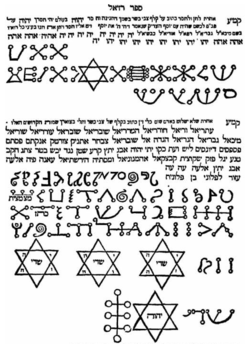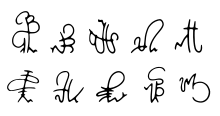Sigil
A sigil (/ˈsɪdʒəl/; pl. sigilla or sigils) is a type of symbol used in magick. The term has usually referred to a type of pictorial signature of a Jinn or other entity. In modern usage, especially in the context of chaos magic, sigil refers to a symbolic representation of the practitioner's desired outcome.

History

The term sigil derives from the Latin sigillum, meaning "seal".[1]
In medieval ceremonial magic, the term sigil was commonly used to refer to occult signs which represented various angels and demons which the magician might summon.[1] The magical training books called grimoires often listed pages of such sigils. A particularly well-known list is in The Lesser Key of Solomon, in which the sigils of the 72 princes of the hierarchy of hell are given for the magician's use. Such sigils were considered to be the equivalent of the true name of the spirit and thus granted the magician a measure of control over the beings.[2]

A common method of creating the sigils of certain spirits was to use kameas (magic squares) — the names of the spirits were converted to numbers, which were then located on the magic square. The locations were then connected by lines, forming an abstract figure.[3]
The word sigil... has a long history in Western magic. The members of the Golden Dawn were perfectly familiar with it (″combining the letters, the colours, the attributions and their Synthesis, thou mayest build up a telesmatic Image of a Force. The Sigil shall then serve thee for the tracing of a Current which shall call into action a certain Elemental Force″) and it was used in the making of talismans. The sigil was like a signature or sign of an occult entity.[4]
The use of symbols for magical or cultic purposes has been widespread since at least the Neolithic era. Some examples from other cultures include the yantra from Hindu tantra, historical runic magic among the Germanic peoples, or the use of veves in Voudon.
Austin Osman Spare
The artist and occultist Austin Osman Spare developed his own unique method of creating and using sigils, which has had a huge effect on modern occultism. Essentially, Spare turned the Medieval practice of using sigils to evoke entities on its head, arguing that such supernatural beings were simply complexes in the unconscious, and could be actively created through the process of sigilization.[5][4]
The big difference with Spare's method was that he dispensed with pre-existing esoterica and external beliefs, so the sigils were no longer for controlling traditional demons, angels and what-have-you, but instead for controlling forces in the unconscious psyche of the individual operator.[4]
Spare's technique became a cornerstone of chaos magic.[6] It also influenced the artist Brion Gysin, who experimented with combining Spare's sigil method with the traditional form of magic squares:
Calligraphic magick squares were one of the techniques most commonly applied by Gysin. He would reduce a name or an idea to a "glyph" and then write across the paper from right to left, turn the paper and do the same again, and so on, turning the paper around and around to create a multi-dimensional grid... The same techniques and consciously driven functional intention also permeated his paintings. In a very real sense, everything he created was an act of sorcery.[7]
Chaos magic

In chaos magic, following Spare, sigils are most commonly created by writing out the intention, then condensing the letters of the statement down to form a sort of monogram. The chaos magician then uses the gnostic state to "launch" or "charge" the sigil – essentially bypassing the conscious mind to implant the desire in the unconscious.[8][6] To quote Ray Sherwin:
The magician acknowledges a desire, he lists the appropriate symbols and arranges them into an easily visualised glyph. Using any of the gnostic techniques he reifies the sigil and then, by force of will, hurls it into his subconscious from where the sigil can begin to work unencumbered by desire.[8]
After charging the sigil, it is considered necessary to repress all memory of it: in the words of Spare, there should be "a deliberate striving to forget it".[5]
In modern chaos magic, when a complex of thoughts, desires and intentions gains such a level of sophistication that it appears to operate autonomously from the magician's consciousness, as if it were an independent being, then such a complex is referred to as a servitor.[9][10] When such a being becomes large enough that it exists independently of any one individual, as a form of "group mind", then it is referred to as an egregore.[11][12]
Later chaos magicians have expanded on the basic sigilization technique. Grant Morrison coined the term hypersigil to refer to an extended work of art with magical meaning and willpower, created using adapted processes of sigilization. His comic book series The Invisibles was intended as such a hypersigil.[6] Morrison has also argued that modern corporate logos like "the McDonald's Golden Arches, the Nike swoosh and the Virgin autograph" are a form of viral sigil:
Corporate sigils are super-breeders. They attack unbranded imaginative space. They invade Red Square, they infest the cranky streets of Tibet, they etch themselves into hairstyles. They breed across clothing, turning people into advertising hoardings... The logo or brand, like any sigil, is a condensation, a compressed, symbolic summoning up of the world of desire which the corporation intends to represent... Walt Disney died long ago but his sigil, that familiar, cartoonish signature, persists, carrying its own vast weight of meanings, associations, nostalgia and significance.[6]

Gordon White developed the technique of shoaling, which involves launching a group of sigils for a set of related aims. For example, instead of sigilizing for "money", sigilizing for a pay rise, new business clients, a promotion, influential new contacts, budget reallocation for your department, etc., all of which help "shift the probability" towards the overall aim.[13][14] White also developed the technique of the robofish, which consists of including a sigil for something that the chaos magician knows will definitely happen, to "lead" the rest of the shoal.[15]
See also
| Look up sigil in Wiktionary, the free dictionary. |
| Wikimedia Commons has media related to Sigils. |
References
Footnotes
- Weschcke, Carl Llewellyn & Slate, Joe H. The Llewellyn Complete Book of Psychic Empowerment
- Lemegeton Clavicula Salomonis: The Lesser Key of Solomon, Detailing the Ceremonial Art of Commanding Spirits Both Good and Evil; ed. Joseph H. Peterson; Weiser Books, Maine; 2001. p.xi-xvii
- Greer, John Michael (2003). The New Encyclopedia of The Occult. Llewellyn Worldwide. p. 438. ISBN 1-56718-336-0.
- Baker, Phil. Austin Osman Spare
- Spare, Austin Osman. The Book of Pleasure
- Morrison, Grant. Pop Magic!
- P-Orridge, Genesis. Magick Squares and Future Beats
- Sherwin, Ray. The Book of Results
- Hine, Phil. Prime Chaos
- Marik. Servitors
- Rysen, Fenwick The Fluid Continuum
- Emerson, Gabriel. Egregore Definition Compilation
- White, Gordon Sigils Reboot
- White, Gordon. Shoaling
- White, Gordon. Magic Secrets as Taught by Robot Fish
Sources
- The Book of Pleasure. Austin Osman Spare ISBN 1-872189-58-X
- Liber Null and Psychonaut. Peter Carroll ISBN 0-87728-639-6
- Baker, Phil (2011). Austin Osman Spare: The Life and Legend of London's Lost Artist. Strange Attractor. ISBN 9781907222016.
- Emerson, Gabriel (1997). "Egregore Definition Compilation". Chaos Matrix. Retrieved June 7, 2018.
- Hine, Phil (1998). Prime Chaos: Adventures in Chaos Magic. New Falcon Publications. ISBN 9781609255299.
- Marik (1998). "Servitors: Part Two of Sigils, Servitors, and Godforms". Chaos Matrix. Retrieved June 7, 2018.
- Morrison, Grant (2003). "Pop Magic!". In Metzger, Richard (ed.). Book of Lies: The Disinformation Guide to Magick and the Occult. Red Wheel Weiser. ISBN 9780971394278.
- P-Orridge, Genesis (2003). "Magick Squares and Future Beats". In Metzger, Richard (ed.). Book of Lies: The Disinformation Guide to Magick and the Occult. Red Wheel Weiser. ISBN 9780971394278.
- Peterson, Joseph H. (ed.), The Lesser Key of Solomon: Lemegeton Clavicula Salomonis (York Beach, ME: Weiser Books, 2001). Considered "the definitive version"
- Rysen, Fenwick (1999). "The Fluid Continuum --or-- What the f***'s an Egregore?". Chaos Matrix. Retrieved June 7, 2018.
- Sherwin, Ray (1992). The Book of Results. Revelations 23 Press. ISBN 9781874171003.
- Spare, Austin Osman (2013). The Book of Pleasure: The Psychology of Ecstasy. Lulu Press. ISBN 9781105502996.
- Weschcke, Carl Llewellyn; Slate, Joe H. (2011). The Llewellyn Complete Book of Psychic Empowerment: A Compendium of Tools & Techniques for Growth & Transformation. Llewellyn Worldwide. ISBN 9780738729862.
- White, Gordon (2012). "Magic Secrets as Taught by Robot Fish". Rune Soup. Retrieved June 7, 2018.
- White, Gordon (2010). "Shoaling: Making Sigil Magic more Awesome Since 2010". Rune Soup. Retrieved June 7, 2018.
- El, Moorpheus (2011). "Secret of Secrets: Reality is Programmable". Matrix-Five. Retrieved August 28, 2011.